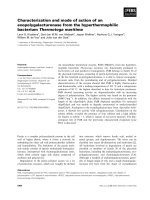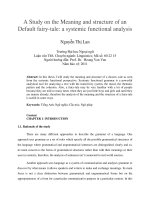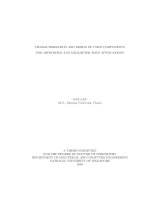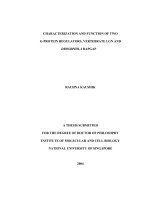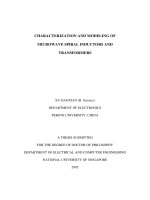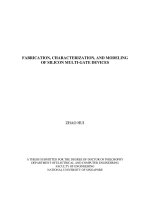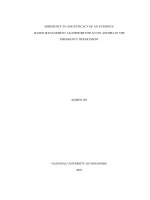Characterization and identifiacation of an actinomyces vnua30 strain with bioactivity against fusarium oxysporum causing the panama disease on banana
Bạn đang xem bản rút gọn của tài liệu. Xem và tải ngay bản đầy đủ của tài liệu tại đây (2.76 MB, 50 trang )
VIETNAM NATIONAL UNIVERSITY OF AGRICULTURE
FACULTY OF BIOTECHNOLOGY
*******
GRADUATION THESIS
CHARACTERIZATION AND IDENTIFICATION OF
AN ACTINOMYCES VNUA30 STRAIN WITH
BIOACTIVITY AGAINST FUSARIUM OXYSPORUM
CAUSING THE PANAMA DISEASE ON BANANA
Student’s name
: Hoang Ngoc Anh
Student’s code
: 610585
Class
: K61CNSHE
Supervisor
: Nguyen Xuan Canh, PhD.
Ha Noi, 2021
GUARANTEE
I hereby commit that the thesis is completely done by me under the
guidance of Nguyen Xuan Canh, PhD. All the data and results that I have
provided in this study are true, accurate and not used in any other report. To the
best of my knowledge and belief, the thesis contains no material previously
published or written by another person except where due reference is made.
I take full responsibility for my commitment to the Academy.
Hanoi, January 2020
Student
i
ACKNOWLEDGEMENTS
I have finished my thesis after six months working in Microbial
Technology Department, with the assistance and guidance of dedicated teachers
at the laboratories of the Department, with my effort to learn own pratice.
First and foremost, I gratefully give acknowledgement to Vietnam
National University of Agriculture for giving us a good environment to study
and a chance of completing my thesis.
Second, my sincere thanks to my principle supervisor Nguyen Xuan
Canh. He guided and supported me so wholehertedly during the time of the
thesis. He gave me lots of advice so I could complete my thesis.
I would like to thanks to all staffs and students at the Laboratory of
Department of Microbial Technology for helping and creating favorable
conditions for me during graduation exercise. They were all very friendly and
helpful to me, I was lucky to study and work in a great enviroment.
Last but not least, I am very approciated to my family and friends for all
their help, encouragement and for supporting me during the process of learning
and research.
Thank you sincerely.
ii
CONTENTS
GUARANTEE ....................................................................................................... i
ACKNOWLEDGEMENTS .................................................................................. ii
LIST OF TABLE ................................................................................................. iv
LIST OF FIGURES .............................................................................................. vi
LIST OF ABBREVIATIONS ............................................................................. vii
ABSTRACT ....................................................................................................... viii
PART 1. INTRODUCTION ................................................................................. 1
1.1. Introduction .................................................................................................... 1
1.2. Purpose and requirements. ............................................................................. 1
1.2.1.Purpose ......................................................................................................... 1
1.2.2.Request ......................................................................................................... 2
PART 2. LITERATURE REVIEW ...................................................................... 3
2.1. Overview of banana and diseases on banana ................................................. 3
2.1.1. Overview of banana .................................................................................... 3
2.1.2. Diseases on Banana ..................................................................................... 6
2.2. Overview of Fusarium oxysporum and Panama disease. .............................. 7
2.2.1 Overview of Fusarium oxysporum .............................................................. 7
2.2.2. Overview of Panama disease ...................................................................... 8
2.3. Overview of Actinomycetes ......................................................................... 10
2.3.1. Definition, classification and distribution of Actinomycetes. .................. 10
2.3.2. Morphological characteristics of actinomycetes ....................................... 11
2.4. Application of actinomycetes ....................................................................... 14
3.1. Materials ....................................................................................................... 15
3.1.1. Materials .................................................................................................... 15
3.1.2. Chemicals, instruments and equipments ................................................... 15
3.1.3. Medium ..................................................................................................... 16
3.1.4. Location and time studies.......................................................................... 17
iii
3.2. Research methods ......................................................................................... 17
3.2.1. Selection of actinomycetes capable of antagonisms with pathogenic
fungi. - Actinomycetes culture method ................................................... 17
3.2.2. Research on biological characteristics and identified actinomycetes ....... 18
PART IV. RESULT AND DISCUSSION .......................................................... 20
4.1. Screening actinomycetes capable of antagonism with fungi. ...................... 20
4.2. Characterization of VNUA30 strain. ........................................................... 21
4.3. Identification of actinomyces VNUA30 based on 16S rRNA sequence ..... 29
4.3.1. DNA extraction ......................................................................................... 29
4.3.2. PCR amplification ..................................................................................... 30
4.3.3. Phylogenetic tree ....................................................................................... 31
PART V. CONCLUSION – SUGGESTION ...................................................... 32
5.1. Conclusion .................................................................................................... 32
5.2. Suggestion .................................................................................................... 32
REFERENCES .................................................................................................... 33
APPENDIX ......................................................................................................... 37
iv
LIST OF TABLE
Table 2.1 Diseases on banana ............................................................................... 7
Table 4.1 Some characteristics of VNUA30 strain after 5 cultured days at
30° ........................................................................................................... 22
Table 4.2 Results of testing the effect of temperature ........................................ 28
Table 4.3 The ability to assimilate different carbon sources of VNUA30
strain after 5 cultured days ...................................................................... 29
v
LIST OF FIGURES
Figure 2.1 Banana trees afflicted with Panama disease ........................................ 9
Figure 3.1 Morphology of Fusarium oxysporum - GT1 on PDA medium ......... 15
Figure 4.1 The results of testing the antifungal activity of actinomyces
VNUA30 strain by dual cultured method after 5 cultured days ............. 20
Figure 4.2 Morphology of VNUA30 strain on the Gause I medium after 5
cultured days at 30°C .............................................................................. 21
Figure 4.3 Conidiophore morphology of VNUA30 strain under optical
microscope at 1000 times magnification after 48 cultured hours ........... 22
Figure 4.4 Salt concentration affect the growth and development of
actinomyces VNUA30 strain. ................................................................. 24
Figure 4.5 Testing the effect of pH ..................................................................... 27
Figure 4.6 The result of total DNA electrophoresis ............................................ 30
Figure 4.7 The result of PCR reaction marker 1500bp ....................................... 30
Figure 4.8 The taxonomic tree based on the sequence of 16S rRNA gene
coding. ..................................................................................................... 31
32
vi
LIST OF ABBREVIATIONS
Abbreviation
Meaning
DNA
Deoxyribonucleic acid
NCBI
National Center for Biotechnology
Information
PCR
Polymerase Chain Reaction
Deoxylribose nucleic acid
DNA
rDNA
Ribosome DNA
vii
ABSTRACT
For the purpose of this research is to characterize and identify the
actinomyces VNUA30 strain with bioactivity against Fusarium oxysporum
causing the Panama disease on Banana. I conducted testing capabilities
antagonism between actinomyces and fungi, then researched the morphology,
physiological- biochemical characteristics and identified the actinomyces with
16s rRNA gene sequencing.
From 30 actinomycete strains were stored at the laboratory, VNUA30
strain had capable of strong resistance to pathogenic fungi. I conducted to
studied
the
morphology
characteristics
and
physiology-
biochemical
characteristics. VNUA30 strain had off- white colonies, bulging center and
globose shape. Optimal temperature of VNUA30 strain is 30°C, VNUA30 strain
belong to alkaline actinomycetes, it grew very well at pH 7-10. Beside,
VNUA30 strain could survice at medium with low salt concentration and had
capable of assimilating different sources from various sugar sources. Based on
morphological characteristics, physiological and biochemical characteristics,
VNUA30 strain was similar to Streptomyces actinomycetes. Moever, by 16s
rRNA gene sequencing the actinomyces VNUA30 strain was identified as
Streptomyces VNUA30.
viii
PART 1. INTRODUCTION
1.1. Introduction
Banana is one of the important crops in Vietnam's agriculture. The
constituents of banana are now using widly in the food industry. Ripe bananas
are known as a nutritious fruit. Beside they may also be used to flavour muffins,
cakes, or breads. Banana not only is known as nutritious fruit but also is
medicinal fruit. The active principles of banana are beneficial to cure skin
diseases, to help in diarrhoea and it is so good for stomatch. Nowadays, in
Vietnam, the cultivation of banana supplies a large amount as nutritious fruit for
consumers demand, bring high economic value to rural economic development.
However, diseases have caused great damage in yield and quality of banana.
One of the main disease in banana is Panama. The disease is caused by fungiFusarium oxysporum. But, the use of chemical substance in the treatment of
diseases was not optimal and one of the best ways to prevent and treat is that
using of bioproducts to inhibit and destroy pathogenic fungi.
Actinomycetes are the most widely- distributed group of microorganisms
in nature, which primarily inhabit the soil (Oskay et al., 2004). They are known
to have the capacity to synthesize bioactive secondary metabolites, which
include enzymes, herbicides, pesticides and antibiotics. Therefore, the study and
use of actinomycetes as well as biologically active substance that they generate
to inhibit pathogenic organisms is a method efficiently and enviromentally
friendly. From this practice, I conducted the theme :”Characterization and
Identification of an Actinomyces VNUA30 strain with bioactivity against
Fusarium oxysporum causing the Panama disease on Banana”.
1.2. Purpose and requirements.
1.2.1.Purpose
Characterization and identification of an Actinomyces VNUA30 strain
with bioactivity against Fusarium oxysporum causing the Panama disease on
Banana.
1
1.2.2.Request
- Test the actinomyces VNUA30 strain with ability of resistant to fungi
Fusarium oxysporum cause diseases in banana.
- Study
some
morphological
and
biochemical,
physiological
characteristics of VNUA30 strain
- Identify VNUA30 strain based on 16S rRNA gene sequencing
2
PART 2. LITERATURE REVIEW
2.1. Overview of banana and diseases on banana
2.1.1. Overview of banana
2.1.1.1. Introduce about banana
Banana, fruit of the genus Musa, of the family Musaceae, one of the most
important fruit crops of the world. A banana is an elongated, edible fruit –
botanically a berry – produced by several kinds of large herbaceous flowering
plants in the genus Musa.
Scientific classification
Kingdom:
Plantae
Order:
Zingiberales
Family:
Musaceae
Genus:
Musa
History
Bananas are thought to have been first domesticated in Southeast Asia,
and their consumption is mentioned in early Greek, Latin, and Arab writings;
Alexander the Great saw bananas on an expedition to India. Shortly after the
discovery of America, bananas were taken from the Canary Islands to the New
World, where they were first established in Hispaniola and soon spread to other
islands and the mainland. Cultivation increased until bananas became a staple
foodstuff in many regions, and in the 19th century they began to appear in the
markets of the United States. Although Cavendish bananas are by far the mostcommon variety imported by nontropical countries, plantain varieties account
for about 85 percent of all banana cultivation worldwide.
Physical Description
The banana plant is a gigantic herb that springs from an underground
stem, or rhizome, to form a false trunk 3–6 metres (10–20 feet) high. This trunk
3
is composed of the basal portions of leaf sheaths and is crowned with a rosette
of 10 to 20 oblong to elliptic leaves that sometimes attain a length of 3–3.5
metres (10–11.5 feet) and a breadth of 65 cm (26 inches) (Banana- Physical
features). A large flower spike, carrying numerous yellowish flowers protected
by large purple-red bracts, emerges at the top of the false trunk and bends
downward to become bunches of 50 to 150 individual fruits, or fingers. The
individual fruits, or bananas, are grouped in clusters, or hands, of 10 to 20. After
a plant has fruited, it is cut down to the ground, because each trunk produces
only one bunch of fruit. The dead trunk is replaced by others in the form of
suckers, or shoots, which arise from the rhizome at roughly six-month intervals.
The life of a single rhizome thus continues for many years, and the weaker
suckers that it sends up through the soil are periodically pruned, while the
stronger ones are allowed to grow into fruit-producing plants
2.1.1.2. The value of banana
The banana is grown in the tropics, and, though it is most widely
consumed in those regions, it is valued worldwide for its flavour, nutritional
value, and availability throughout the year. After rice, wheat and milk, it is the
fourth most valuable food. In export, it ranks fourth among all agricultural
commodities and is the most significant of all fruits, with world trade totaling
$2.5 billion annually. Only 10% of the annual global output of 86 million tons
enters international commerce.
In 100g raw bananas (not including the peel) are 75% water, 23%
carbohydrates, 1% protein, and contain negligible fat. A 100-gram reference
serving supplies 89 Calories, 31% of the US recommended Daily Value (DV) of
vitamin B6, and moderate amounts of vitamin C, manganese and dietary fiber,
with no other micronutrients in significant content.
4
Ripe bananas are known as a nutritious fruit. Beside they may also be used to
flavour muffins, cakes, or breads. Cooking varieties, or plantains, are starchy
rather than sweet and are grown extensively as a staple food source in tropical
regions. A ripe fruit contains as much as 22 percent of carbohydrate and is high
in dietary fibre, potassium, manganese, and vitamins B6 and vitamins C.
Health Benefits of Banana
- High in nutrients:
Bananas are packed with vitamins, minerals, fibre and simple sugar. They
contain no fat/cholesterol. Bananas are a rich source of vitamin B6, folate,
vitamin C, magnesium, potassium and carbohydrates. One banana is enough to
keep the stomach full for a long time.
- Keeps a check on diseases:
Being rich in magnesium & potassium, banana aids in maintaining
optimum blood pressure, keeps the heart protected and promotes bone health.
- Stomach friendly:
It fights build up of acid (have an antacid effect) and also protects stomach
lining from ulcers. Banana also guards the stomach against unfriendly bacteria
which are responsible for causing gastrointestinal disturbances.
- Helps in diarrhoea:
Bananas are a good home remedy for loose stools (diarrhoea) as they work
as a binding agent. Diarrhoea dehydrates the body and rips it off some vital
electrolytes. Banana helps in restoring those lost nutrients.
- Post workout snack:
It is an ideal post workout food, especially after strenuous aerobic
exercises. It contains simple sugars which provide instant energy, and potassium
which is much needed by the muscles after a workout.
- Cures skin diseases:
5
The white lining inside of the banana peel is a known remedy for treating
psoriasis, acne and other skin conditions. Banana peel is also known to have
proven effect in treating warts and minor burns.
- Remedy for hangover:
In case of a bad hangover in the morning post a binge drinking session,
bananas come handy in overcoming it. Having a banana smoothie made of
milk/curd, banana with some milk and few strawberries gives relief from
hangover.
- Whitens teeth:
Inside of the banana peel is the effective and inexpensive way of whitening
yellow teeth. Gently rubbing the inside part of the banana peel for about 2
minutes will give the desired effect of white and bright teeth.(Health benefits,
nutritional facts).
2.1.2. Diseases on Banana
Banana is one of the most important plant in Agriculture. It not only is known as
nutritious fruit but also is medicinal fruit. Nowadays, Banana brings high
economic value to rural economic development. However, diseases have caused
great damage in yield and quality of banana. Bananas are very susceptible to
disease caused by bacteria, fungi and virus.
Microoganisms
Bacteria
Disease
Bacterial wilt
Bugtok
Finger tip rot
Moko
Fungi
Agent
Pseudomonas
solanacearum
Ralstonia solanacearum
Pseudomonas spp
Ralstonia solanacearum
Panama disease
Fusarium oxysporum
f.sp. Cubense
Anthracnose
Brown spot
Collectotrichum musae
Cercospora hayi
6
Virus
Crown rot
Fungal scald
Root and rhizome
rot
Black cross
Black root rot
Eyespot
Pseudostem heart
rot
Yellow Sigatoka
Bract mosaic
Fusarium pallidoroseum
Collectotrichum musae
Cylindrocarpon musae
Bunchy top
Mosaic
Streak
Banana mild
mosaic
Banana bunchy top virus
Cucumber mosaic virus
Banana streak virus
Banana mild mosaic
virus
Phyllachora musicola
Rosellinia bunodes
Drechslera gigantea
Fusarium moniliforme
Mycosphaerella musicola
Banana bract mosaic
virus
Table 2.1 Diseases on banana
Most of disease on banana is caused by bacteria, fungi and virus. Therefore, the
study and use of actinomycetes as well as biologically active substance that they
generate to inhibit pathogenic organisms is a method efficiently and
enviromentally friendly.
2.2. Overview of Fusarium oxysporum and Panama disease.
2.2.1 Overview of Fusarium oxysporum
2.2.1.1. Distribution and classification
Fusarium oxysporum is well-known as a plant pathogen causing severe
damage in many agricultural crops, both in the field and during postharvest
storage. Fusarium oxysporum is an ascomycete fungus, comprises all the
species, varieties and forms recognized by Wollenweber and Reinking within an
infrageneric grouping called section Elegans. It is part of the family Nectriaceae.
7
2.2.1.2. Characterization of F. oxysporum
Fusarium taxonomy has been based on morphological characteristics of
the anamorph, including the size and shape of macroconidia, the presence or
absence of microconidia and chlamydospores, colony colour, and conidiophore
structure (Windels, 1992). The difficulty in delineating species based on these
features is evidenced by the many different systems that have been proposed,
recognizing anywhere from 30 to 101 species (Booth, 1971; Gerlach &
Nirenberg, 1982; Nelson et al., 1983). Many of these taxonomic schemes group
the species into sections
Based on morphological criteria, it is sometimes difficult to distinguish F.
oxysporum from several other species belonging to the sections Elegans and
Liseola. To further complicate the picture, plant pathogenic, saprophytic and
biocontrol strains of F. oxysporum are morphologically indistinguishable.
2.2.1.3. Diseases are caused by Fusarium oxysporum
Fungal phytopathogens cause serious problems world- wide in agriculture
and food industry by destroying crops and economically important plants in the
field and during storge. Fusarium oxysporum as know as the pathogenic strains
that cause Fusarium wilt ( Panama disease).
2.2.2. Overview of Panama disease
2.2.2.1. Introduction about Panama disease
Panama disease, also called banana wilt, a devastating disease of bananas
caused by the soil-inhabiting fungus species Fusarium oxysporum. A form of
fusarium wilt, Panama disease is widespread throughout the tropics and can be
found wherever susceptible banana cultivars are grown. Notoriously difficult to
control, the disease decimated global plantations of the Gros Michel banana in
the 1950s and ’60s, which had dominated the commercial industry until its
downfall. Its replacement, the modern Cavendish, has been threatened with a
8
strain of the disease known as Tropical Race (TR) 4 since the 1990s; in 2019 TR
4 was confirmed in Colombia, marking the first appearance of the strain in the
Americas.
2.2.2.2. Symptoms of Panama disease.
Two external symptoms help characterize Panama disease of banana:
- Yellow leaf syndrome, the yellowing of the border of the leaves which
eventually leads to bending of the petiole.
- Green leaf syndrome, which occurs in certain cultivars, marked by the
persistence of the green color of the leaves followed by the bending of the
petiole as in yellow leaf syndrome.
Figure 2.1 Banana trees afflicted with Panama disease
The Fusarium fungus invades young roots or root bases, often through
wounds. Some infections progress into the rhizome (rootlike stem), followed by
rapid invasion of the rootstock and leaf bases. Spread occurs through vascular
bundles, which become discoloured brown or dark red, and finally purplish or
black. The outer edges of older leaves turn yellow. Within a month or two, all
but the youngest leaves turn yellow, wilt, collapse, and hang downward,
covering the trunk (pseudostem) with dead brown leaves. All aboveground parts
9
are eventually killed, although fresh shoots may form at the base. These later
wilt and the entire plant dies, usually within several years. The Fusarium fungus
then continues to thrive in surrounding soil, preventing the success of future
plantings.
2.3. Overview of Actinomycetes
2.3.1. Definition, classification and distribution of Actinomycetes.
2.3.1.1. Definition
Actinomycetes are unicellular, Gram-positive bacteria that belong to the
Order Actinomycetales.
Members of this group are widely distributed in nature and can be found
in a variety of habitats across the world
The name Actinomycetes is derived from the Greek words "atkis" which
means ray and "mykes/mukes" which means fungi.
2.3.1.2. Classification and distribution
2.3.1.2.1. Classification
Kingdom:
Bacteria
-
As
members
of
the
kingdom
Bacteria,
Actinomycetes are unicellular organisms characterized by a simple cell
structure. Although they can be found in various environments across the world,
some of the species can cause diseases in human beings. As Gram-positive
bacteria, they also contain a peptidoglycan layer in their cell wall.
Phylum: Actinobacteria - As members of the Phylum Actinobacteria,
Actinomycetes are Gram-positive bacteria characterized by a high G+C content
in their DNA. They can be found in terrestrial and aquatic environments where
they exhibit high nutritional versatility. Members of this group also produce
mycelium.
Subclass: Actinobacteridae - The subclass Actinobacteridaeis is diverse
and consists of a wide range of organisms that can be found in various habitats.
10
As a subclass under the phylum Actinobacteria, members of this group produce
mycelium.
Order: Actinomycetales - Members of the order Actinomycetales are
known as Actinomycetes. They are diverse in nature and can be found in both
aquatic and terrestrial environments. Actinomycetes are Gram-positive bacteria
and aerobic (some members of the group are anaerobic). They are also
characterized by a filamentous pattern of growth
2.3.1.2.2. Distribution
As members of the phylum Actinobacteria, Actinomycetes are widely
distributed in different parts of the world. Because they can live in different
environments and exhibit high versatility in their nutrition, this allows them to
spread and thrive in different regions across the globe and compete with other
organisms in their surroundings.
Some of the species are capable of surviving in various extreme
environments and can, therefore, be classified based on these habitats:
- Alkalophilic species - Identified in soda lake soil (e.g. Bogoriella
caseilytica)
- Halophilic species - Survive in areas with high salt concentrations (e.g.
Saccharomonospora halophila)
- Psychrophilic species - Commonly found in very low temperatures
(e.g. Modestobacter multistep-tatus).
2.3.2. Morphological characteristics of actinomycetes
Depending on the species, Actinomycetes range in size from 0.5um to
over 5.0um ( T Roseburry.1994 )
2.3.2.1.Colonies
On the solid medium, the actinomycetes forms colonies.
11
Colonies size depends on the medium and conditions of cultivation.
Colonies of actinomycetes are usually dry, rugged, rough and with several forms
such as: skin, limestone, chalky. The colonies often have radioactive or
concentric circles form. The color of the colonies are so diverse, with different
colors such as red, yellow, gray, brown, white, and so on…Depending on the
species, culture conditions and medium component, temparature and pH… the
size and shape of the colonies also changes.
The colony has 3 layers, they are outer layer, middle layer and the inside
layer. The outer layer has brained fibers, the inside layer is relatively porous and
the middle layer has a honey comb structure.
2.3.2.2. Spores and sporulation
Spore formation is characterized by septation at several intervals of the
aerial hyphae. This involves the invagination of the plasma membrane as well as
a break in the inner wall. The inner hyphal wall then starts to thicken to form a
thick wall.
It's worth noting that during sporulation, the nuclear material that had
been dividing is constricted at the septum and ultimately divides as the septation
process ends. A thick wall forms around each of the spores as new material is
added to the wall (at the septa).
According to a number of studies, the sporulation process may occur
through fragmentation of the hyphae or endogenous spore formation. In cases
where the spores are formed through fragmentation/subdivision of the hyphae,
the spores formed may be covered by a sheath even after fragmentation.
However, this is not the case with all species. Through fragmentation, several
types of spores are produced. These include; aleuriospores (produced by hypha
without a sheath), arthrospores (produced by sheathed hyphae), and endospores
(formed within vesicles).Depending on the species, they vary in size from about
0.5 to 1.5um. Apart from a thicker wall structure, some of the spores have sharp
12
spines originating from the sheath. Moreover, they also contain the genetic
material and cytoplasm of the parent.
In the soil, or in the event of adverse environmental conditions, the spores
(dormant) are able to survive for a long period of time.
Under favorable environmental conditions, the spores germinate to
produce germ tubes. These germ tubes then grow/extend to form mycelium that
consists of branching filaments which are also known as hyphae.
2.3.2.3. Cell wall of actinomycetes
Like many other bacteria, Actinomycetes have a cell wall (mycelial wall)
covering the organism. This cell wall is made up of a number of components
including amino acids, sugars, as well as amino sugars. This cell wall also
consists of a peptidoglycan layer that consists of diaminopimelic acid in a
majority of the species.
Cell wall consists of three layers: the outermost layer is thick about 60120Ȧ, when the elderly can reach 150-200Ȧ, the solid middle layer is thick
about 50Ȧ, the inner layer is thick of approximately 50Ȧ. Cell walls of
actinomycetes do not contain cellulose and chitin that are commonly found in
the cell wall of fungi but contain enzymes involved in the metabolisms and
transport process through the membrane material.
2.3.2.4. Physiological – biochemical characteristics of actinomycetes
Actinomycetes belong to heterotrophic organisms. Most actinomycetes
are non- motile. Research on the physiological characteristics – biochemistry of
the actinomycetes is studying of the possibility of the assimilating carbon and
nitrogen sources, the demand for oxygen, pH limits, the optimum temparatura,
salt tolerance and other factors of the enviroment, anatogonistic and sensitive to
antibiotics, ability to form antibiotics and other specific metabolic products os
actinomycetes. Sugar, starch, organic acids, lipids, amino acids, proteins, and
many other organic compounds are the sources of carbon and enrgy. Sources of
13
nitrogen are usually nitrate salts, ammonium sakts, peptones, proteins…The
ability to assimilate substances in each actinomycetes strain is different.
The majorities of actinomycetes are aerobic and good moisture
microorganisms, a few thermophilic. Most actinomycetes grow well in media
with a neutral pH or slightly alkaline, proper temparature for growth is in the
range of 25°C- 45°C. However, with each different species of actinomycetes,
isolate from different sources and in different regions, different countries, the
physiological- biochemical characteristics will be different a lot to able to adapt
living condition.
2.4. Application of actinomycetes
Actinomycetes are the most widely- distributed group of microorganisms
in nature, which primarily inhabit the soil (Oskay et al., 2004). They are known
to have the capacity to synthesize bioactive secondary metabolites, which
include enzymes, herbicides, pesticides and antibiotics. Enzymes such as
amylase, lipase, and cellulases produced from actinomycetes play an important
role in food, fermentation, textile and paper industries. Certain enzymes used as
therapeutic agents in human cancer, mostly in acute lymphoblastic leukemia.
Actinomycetes are useful in cancer treatment, bioremediation and it produces
some valuable antibiotics such as novobiocin, amphotericin, vancomycin,
neomycin, gentamycin, chloramphenicol, tetracycline, erythromycin, nystatin,
etc. Actinomycetes are also used as plant growth promoting agents, biocontrol
tools, biopesticide agents, antifungal compounds, and biocorrosion and as a
source of agroactive compounds. Therefore, actinomycetes play a significant
role in the production of various antimicrobial agents and other industrially
important substances such as enzymes.
Therefore, the study and use of actinomycetes as well as biologically
active substance that they generate to inhibit pathogenic organisms is a method
efficiently and enviromentally friendly.
14
PART III. MATERIALS AND METHODS
3.1. Materials
3.1.1. Materials
Actinomycetes were stored in laboratory of Department of Microbial
Technology- Faculty of Biotechnology- Vietnam National University of
Agriculture.
Pathogenic fungi was stored in laboratory of Department of Microbial
Technology- Faculty of Biotechnology - VietNam National University of
Agriculture. The strain is GT 1- Fusarium oxysporum: White filamentous
fungus, big colony size, grow very fast, the mycelium changes to purple when it
older.
Figure 3.1 Morphology of Fusarium oxysporum - GT1 on PDA medium
3.1.2. Chemicals, instruments and equipments
- Chemicals
The chemicals used in the study of microorganisms and some other
chemicals such as: Soluble starch, Glucose, Fructose, Yeast Extract, Malt
Extract, K 2 HP0 4 , MgS0 4 , NaCl, KN0 3 , FeS0 4 ,…
-Instrucments and equipments
15
The instrucments and equipment used in Microbial Technology
Laboratory- Faculty of Biotechnology- Vietnam National University of
Agriculture: Vortex shaker, optical microscope, shaking machine, incubator,
pipettes, refrigerators, pH meter,…
3.1.3. Medium
- Gause I medium (g/l): 20g of Soluble Starch, 0.5 g of K 2 HP0 4 , 0.5g of
MgS0 4 .7H 2 0, 0.5g of NaCl, 0.5g of KN0 3 , 0.01g of FeS0 4 .7H 2 0, 20g of Agar, 1
liter of distilled water, pH 7-7.4.
- Gause II medium (g/l): 30 ml of Meat Extract Water, 5g of Peptone, 5g
of NaCl, 10g of Glucose, 20g of Agar, 1 liter of H 2 0, pH 7-7.2.
- PDA medium (g/l): 200g of potato, 20g of glucose, 1 liter of distilled
water, pH 6
- ISP1 medium (g/l): 5g of Tryptone, 3g of Yeast Extract, 20g of Agar, 1
liter of distilled water, pH 7- 7.2.
- ISP2 medium (g/l): 4g of Yeast Extract, 10g of Malt Extract, 4g of
Glucose, 20g of Agar, 1 liter of distilled water, pH 7.3.
- ISP3 medium (g/l): 20g of Oatmeal, 20g of Agar, 1.0 ml of
Micronutrient Salt Solution, 1 liter of distilled water, pH 7-7.4.
- ISP4 medium (g/l): 10g of Starch, 1 g of , 1g of MgS0 4 .7H 2 0, 1g of
NaCl, 2g of (NH 4 ) 2 S0 4 , 2g of CaC0 3 , 1.0 ml of Micronutrient Salt Solution, 1
liter of distilled water, pH 7-7.4.
- ISP5 medium (g/l): 1g of L- asparagine, 10g of glycerol, 1 g of K 2 HP0 4 ,
1.0 ml of Micronutrient Salt Solution, 1 liter of distilled water, 20g of Agar, pH
7-7.4.
-ISP6 medium (g/l): 10g of peptone, 1g of Yeast Extract, 0.5g of Xitrat,
20g of Agar, 1 liter of distilled water, pH 7-7.2.
Micronutrient salt solution of IPS: 0.01g of FeS0 4 .7H 2 0, 0.1g of MnCl 2 .4
H 2 0, 0.1g of ZnS0 4 . 7H 2 0, water to 100ml, pH 7-7.2.
16
